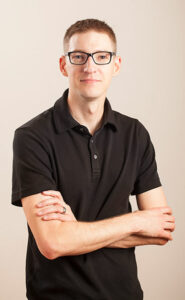Article by Sarah Kuta
As tech startups come and go, programming languages become trendy or fall out of favor and emerging technologies disrupt the status quo, there is one skill that has remained constant in the field of computer science: understanding people.

Though there’s no question Eric Wendelin, Class of 2005, mastered the technical abilities needed to succeed as a software engineer during his time at Adams State University, he also learned other valuable skills, both inside and outside the classroom — how to work on a team, how to communicate with and manage other people and how to solve real-world problems that don’t have an easy engineering solution, just to name a few.
“The easiest part of my job is actually writing software,” said Wendelin. “The human pieces are far more complex and I was able to learn more of those softer qualities, those less-technical qualities, in great part because I went to Adams State University.”
Wendelin will receive the Adams State 2019 Outstanding Alumnus Award at the Homecoming Alumni Banquet and Awards Ceremony on October 18. For reservations and tickets, call the ASU Alumni Relations Office at 719-587-8110.
Early in his life, Wendelin wanted to become a video game designer when he grew up, which led him to the computer science program at Adams State. But Wendelin, 35, later understood that making video games was a tough job with long hours and low pay, so he turned his attention instead to software and computers.
Wendelin, who also studied math and physics, graduated magna cum laude in 2005. Since then, he’s worked as a software engineer and manager for a number of influential companies, including Twitter, Apple, Time Warner Cable, Return Path and Sun Microsystems. Today, Wendelin is an open-source enthusiast, blogger, speaker and the head of analytics for Gradle, which makes tools and systems for developers.
Wendelin’s flexibility and willingness to acquire new skills have allowed him to work on a diverse array of projects and platforms. That varied experience has, in turn, helped him to see the bigger picture and take on various leadership and strategy roles.
“I can understand most of the pieces of what’s happening around me in the company, which means I can have a large impact,” he said.
Nearly 15 years into his career, Wendelin still thinks about the lessons he gleaned from professors at Adams State.
From George Sellman, assistant professor of computer science, Wendelin learned how to look at tough problems from different perspectives, an invaluable tool out in the real world of software engineering.
“Folks would have a question and instead of answering straight he would say, ‘Well, here are the different aspects to that problem. You could think of it this way, or you could think of it another way,’” Wendelin said. “He taught us how to think about the problem, versus how to solve it.”
Wendelin also employs tactics he gleaned from Matt Nehring, Ph.D., professor of physics, when faced with a challenge that initially seems insurmountable.
“He taught me how to break problems down into their simplest forms and not to give up solving them, even when they are difficult,” Wendelin said. “In physics, we’d have problems that would take pages and pages of work. He taught us that there were parts that didn’t matter as much and other fundamental components that we could solve independently.”
At Adams State, Wendelin kept busy with a number of student organizations and activities. He served on the Grizzlies Activities Board and was the president of the Adams State Computer Science Mathematics and Engineering Club. He also participated in student government, the business fraternity Phi Beta Lambda and the service organization Circle K.
Looking back now, Wendelin can see clearly how participating in these organizations during his time at Adams State still benefits him today as a team leader and a manager.
“Some engineers only know how to solve engineering problems, and that can only get you so far,” he said. “(Student organizations) were crucial for learning how to actually achieve things in the real world, where it’s not all just software.”



